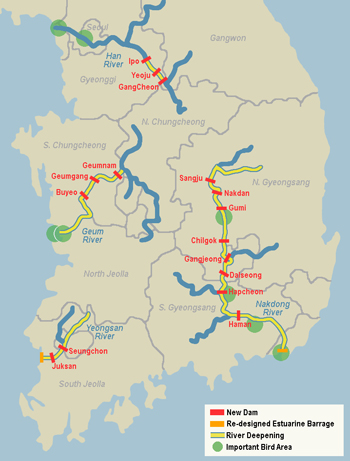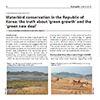
4 Rivers
The Four Rivers:
“Building A Greener Korea”
The Grand Canal project aimed to create shipping routes along the nation’s major rivers, from the sea to the mountains back to the sea again. It was postponed in 2008 due to massive public opposition, in the run-up to the Tenth Ramsar Convention conference (October 28th – November 4th, Changwon, Republic of Korea). A revised river plan was then proposed in December 2008. Even while large-scale engineering work started, an environmental impact assessment was hastily conducted in approximately four months (summer 2009). On November 10th 2009, the project was formally launched. This Four Rivers project entails by 2012 the “restoration” or “refurbishment” of the nation’s four largest rivers – the Han, the Nakdong, the Geum and the Yeongsan. According to an authoritative NGO report submitted to the United Nations Environmental Program on July 31st: “Most of the total budget of 22.2 trillion Korean Won (USD 17.8 billion) [for this project] will be spent by 2012 to build more than 16 new dams on the mainstreams of the four rivers and five new dams on their tributaries, to raise 87 existing irrigation dams, to strengthen 377 km of river bank and to dredge 570 million cubic meters of sand and gravel from 691 km long sections of the rivers to keep the water 4-6m deep of the four rivers and to strengthen 243 km of river bank, and to raise nine existing irrigation dams in other tributaries and river basins.” (KFEM, July 31st 2009). Two new estuarine barrages will also be re-built, on the west Nakdong and on the Yeongsan (both rivers to be deepened by dredging). Subsequent press releases and promotion campaigns emphasise that the new dams will beautify the rivers; that the project will increase recreational opportunities through the creation of over 1700 km of bicycle roads along the rivers, linked by cruise ships, rest areas and restaurants; and that the rivers will come alive with wildlife. The Four Rivers is also the model for a new Masterplan being developed for the fuller utilisation of all of the nation’s rivers. The Birds Korea preliminary report on the anticipated impacts on waterbirds of the Four Rivers is still in progress (January 2010). Based on the information available to us, we believe that the Four Rivers project will cause very major and long-term negative impacts on several bird species, on eight BirdLife designated Important Bird Areas, and on at least one Ramsar site (Upo wetland). Dredging and a change in water levels will for example destroy the habitat of the Long-billed Plover Charadrius placidus and the globally Endangered Scaly-sided Merganser Mergus squamatus; disturbance will increase greatly, leading to the further decline of sensitive species like the Mandarin Duck Aix galericulata; and estuaries will be impacted through increased river pollution loads and an increase in shipping and infrastructure, in addition to reduced opportunities for much-needed ecological restoration.
Articles


The Rivers Are Alive!
February 2009
February 2009
Organizational Responses

Ten Principles of River Restoration and Four Rivers Project of Korea
• Presentation (PDF)
• Text (PDF in English & Korean)
SAVE International
• Presentation (PDF)
• Text (PDF in English & Korean)
SAVE International

Let the rivers flow
Professor's Organization for Movement Against Grand Korean Canal (POMAC)
Korean Water Society
Professor's Organization for Movement Against Grand Korean Canal (POMAC)
Korean Water Society
Media Links
 |
|
 |
|
Project Promotion Links

- River project focuses on environment, leisure January 2010
- Bringing four rivers back to life January 2010
- Homegrown plants to adorn Korea's four major rivers December 2009
- Four major rivers's sluices to beautify Korea's landscape
- Designs of 16 weirs on four major rivers unveiled November 2009
- Several foreign investors interested in Korean canal project Birding Asia 10 2008: 48-53













